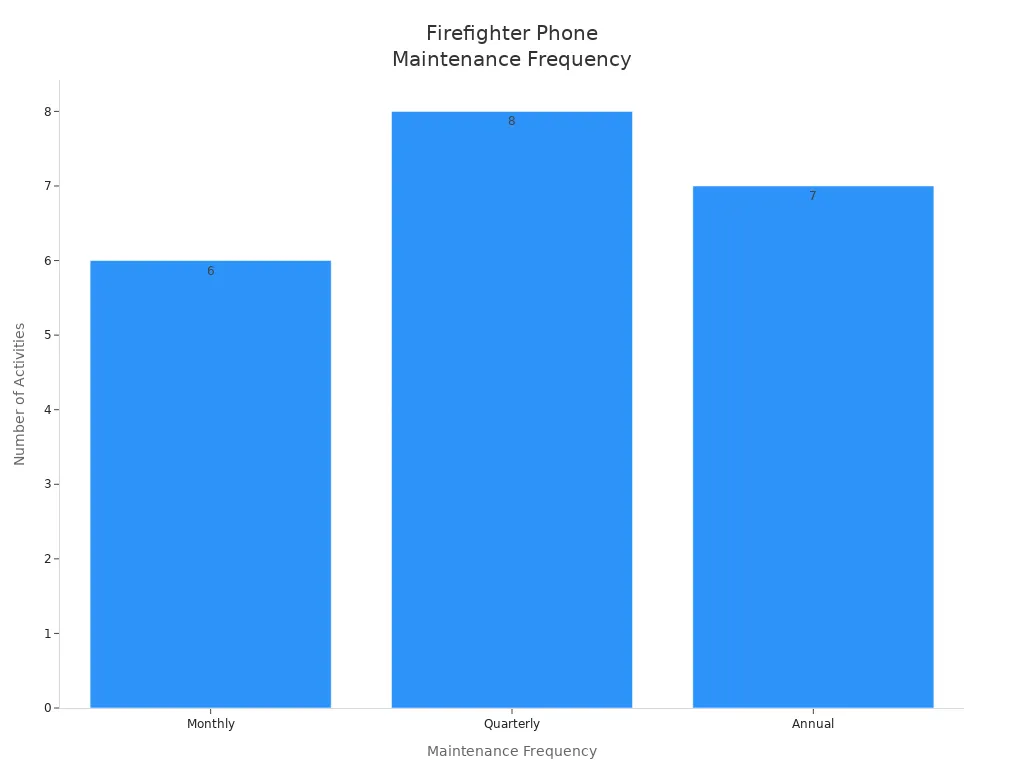
Firefighters depend on a firefighter telephone handset for clear, direct communication during emergencies. This equipment must guarantee safe operation and seamless integration with fire alarm systems. Reliable performance helps ensure rapid coordination and supports critical decision-making when lives and property remain at risk.
Key Takeaways
- Firefighter telephone handsets must provide reliable, clear communication under extreme conditions using durable design and backup systems to ensure safety during emergencies.
- These handsets need to work seamlessly with fire alarm systems and building wiring, using universal connectors and supervised circuits to maintain constant, fault-free communication.
- Regular inspection and maintenance, including monthly and annual tests, keep firefighter telephone handsets ready and compliant with safety standards for effective emergency response.
Essential Qualities of a Firefighter Telephone Handset
Reliability in Emergency Situations
A firefighter telephone handset must deliver consistent performance under extreme conditions. Industry experts highlight several critical features that define reliability:
- Hybrid 4G/5G broadband connectivity for enhanced communication
- Situational awareness tools, including live video feeds and location sharing
- Secure communications that meet regulatory requirements
- Ergonomic design for hazardous environments
- Integration with smart applications to improve safety and efficiency
Firefighter telephone handsets undergo rigorous environmental testing. Devices face cycles of baking at high temperatures, water immersion, vibration, and impact tests. Manufacturers design controls for use with gloves and large hands, ensuring accessibility during emergencies. Self-checking capabilities, visual and audible battery indicators, and clear voice transmission standards further support reliability. These features help prevent communication failures that have historically led to tragic outcomes.
Tip: Firefighter telephone handsets often include long-lasting batteries and backup communication connections, such as LTE or broadband, to maintain contact if the primary system fails.
Compatibility with POTS and Fire Alarm Systems
Compatibility with Plain Old Telephone Service (POTS) and modern fire alarm systems remains essential. Firefighter telephone handsets must interface seamlessly with building infrastructure. This ensures that emergency calls reach the right personnel without delay. Universal connectors and programmable features guarantee interoperability across different systems. Compliance with standards like NFPA 1802 confirms that devices meet minimum performance criteria and test procedures.
Robust Building Wiring and Supervision
Reliable communication depends on robust building wiring and supervision. Firefighter telephone handsets connect to supervised circuits that monitor line integrity. These circuits detect faults or tampering, alerting responders to potential issues before they compromise safety. Durable remote speaker microphones and cables withstand harsh environments, supporting uninterrupted communication throughout a building.
| Feature | Description |
|---|---|
| Supervised Wiring | Monitors line integrity and detects faults |
| Durable Cables | Withstand heat, moisture, and physical stress |
| Universal Connectors | Ensure interoperability with various fire alarm systems |
| Programmable Functions | Maintain operation under hazardous conditions |
Specialized Safety Mechanisms
Specialized safety mechanisms protect users during emergencies. Firefighter telephone handsets provide a dedicated, instant communication channel within fire alarm systems. This enables real-time exchange of incident updates, resource requests, and situation assessments. Devices feature sturdy construction and durable materials to withstand harsh firefighting conditions. Seamless integration with emergency systems supports effective response and enhances safety for both responders and the public.
Note: Ergonomic controls, emergency alert buttons, and hazard-zone modes allow firefighters to operate devices quickly and efficiently, even in stressful situations.
Integration with Elevator Jacks
Integration with elevator jacks allows firefighter telephone handsets to function in critical building locations. During a fire, elevators may become staging points for rescue operations. Handsets connected to elevator jacks enable direct communication between firefighters and command centers. This feature supports coordination, resource allocation, and rapid response when every second counts.
Safety Standards and Compliance for Firefighter Telephone Handset

Adherence to Fire Code Requirements
Fire codes play a crucial role in shaping the design and deployment of firefighter telephone handsets. Historically, regulations such as the 2003 International Building Code section 907.2.12.3 required wired Emergency Communications System (ECS) handsets in high-rise commercial buildings. These devices provided a direct link between incident commanders and firefighting teams. Over time, fire codes have evolved. Jurisdictions like New York City now favor wireless Emergency Responder Radio Coverage Systems (ERRCS) or Fire Department Auxiliary Radio Communication Systems (ARCS). This shift reflects a growing recognition that fixed, corded handsets limit mobility and efficiency. Modern standards prioritize wireless solutions for improved safety and operational effectiveness.
Note: Firefighter Telephone Handset requirements continue to change as technology advances and fire codes adapt to new risks.
Certification and Testing Protocols
Manufacturers must certify firefighter telephone handsets to meet industry standards. Testing protocols include environmental stress tests, audio clarity assessments, and system integration checks. Devices undergo evaluation for durability, reliability, and compatibility with building communication systems. Certification ensures that each handset performs as expected during emergencies. Third-party organizations often verify compliance, adding an extra layer of trust for building owners and fire safety professionals.
Ongoing Maintenance and Inspection
Routine maintenance and inspection guarantee the continued reliability of firefighter telephone handsets. Industry standards recommend a structured schedule:
| Frequency | Key Inspection and Maintenance Activities |
|---|---|
| Monthly | Visual inspection of physical condition; check accessibility and visibility; look for damage or tampering; verify normal operation; check trouble signals; document in log |
| Quarterly | Includes all monthly tasks; functional test of phone jack connection; verify two-way communication; check audio quality and volume; confirm identification at command center; test at least 20% of jacks on rotating basis; document results |
| Annual | Includes all quarterly tasks; complete functional testing of all phone jacks; detailed circuit testing and measurements; backup power operation testing; system integration verification; comprehensive documentation; third-party certification if required |

Regular inspections help identify issues before they affect emergency communication. Fire safety teams document each activity to maintain compliance and ensure readiness.
A Firefighter Telephone Handset must deliver reliability, safety, and system compatibility. The table below highlights essential features and certifications that support secure communication during emergencies.
| Category | Details |
|---|---|
| Reliability Features | Circuit supervision, LED status displays, multi-jack audio, simultaneous remote operation |
| Safety Certifications | UL 864 listed, seismic certification, compliance with major building codes |
| System Compatibility | Supports up to 24 jacks, configurable wiring, auto-program, trouble relay |
Key features such as heavy-duty construction, secure access, and instant alerts help firefighters respond quickly and protect lives. Industry experts recommend thorough system evaluation, code compliance, and scheduled maintenance to ensure ongoing performance.
- Quick identification and rugged design reduce response time.
- Real-time alerts and clear audio improve coordination.
- Scheduled inspections maintain system readiness.
FAQ
What makes a firefighter telephone handset different from a regular phone?
A firefighter handset uses rugged materials, supervised wiring, and emergency features. It connects directly to fire alarm systems and supports reliable communication during emergencies.
How often should teams inspect firefighter telephone handsets?
Teams should inspect handsets monthly. They check for damage, test connections, and document results. Regular inspections help ensure the system works during emergencies.
Can firefighter telephone handsets work with wireless systems?
Some modern handsets support integration with wireless emergency responder systems. Compatibility depends on the building’s fire protection infrastructure and local code requirements.

